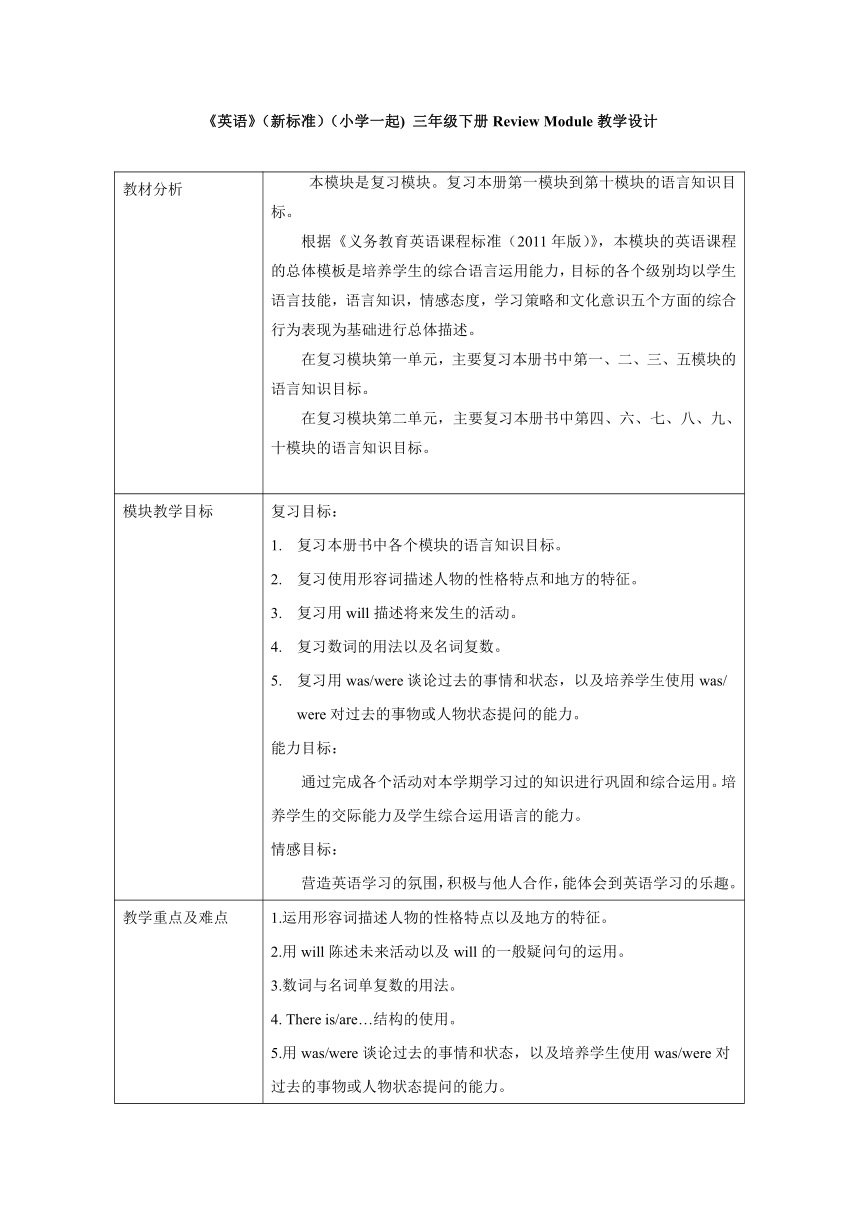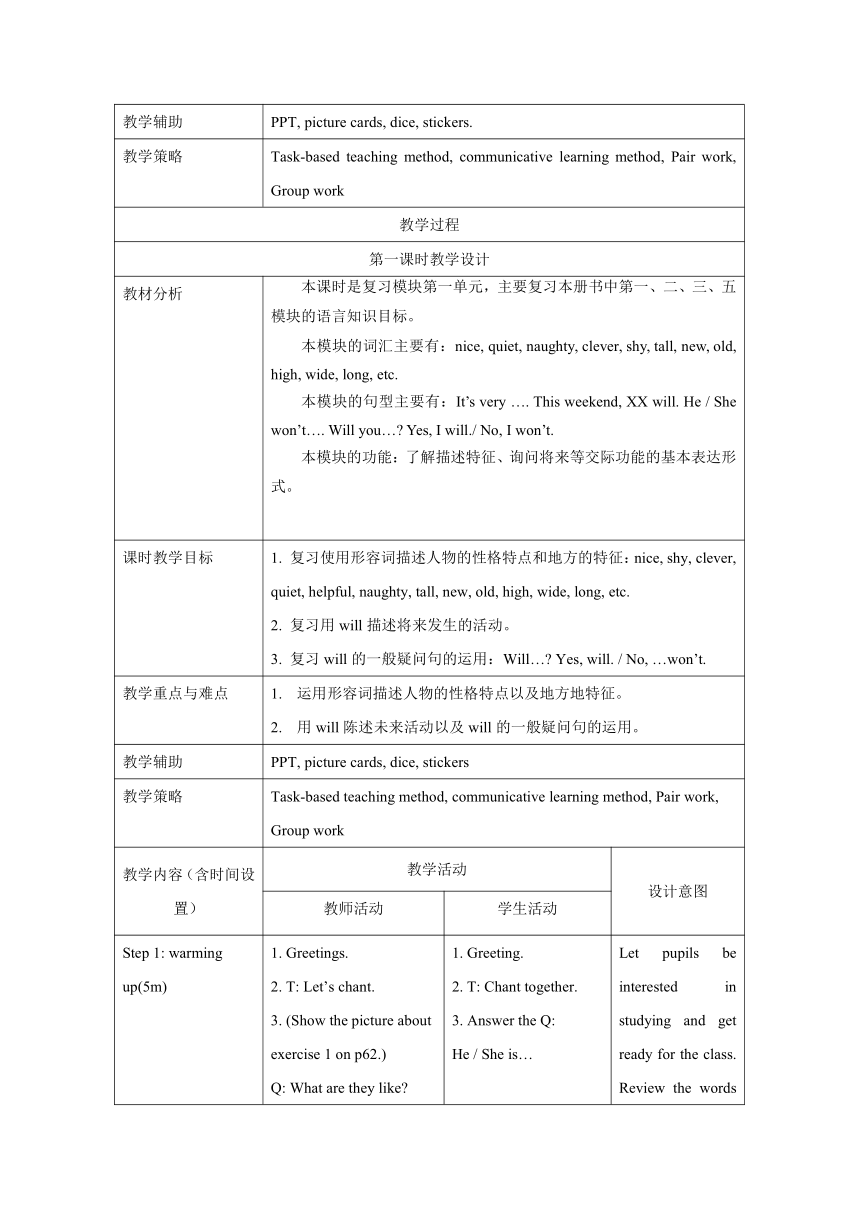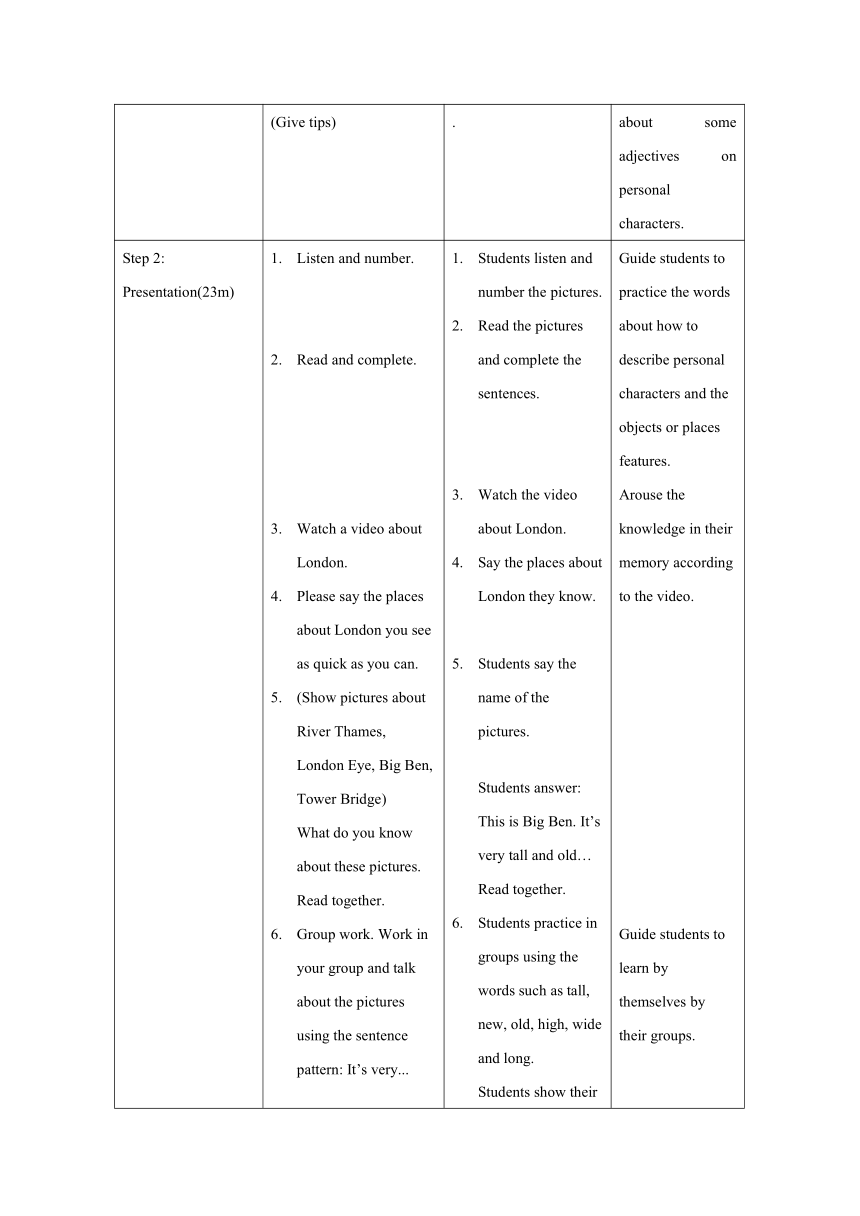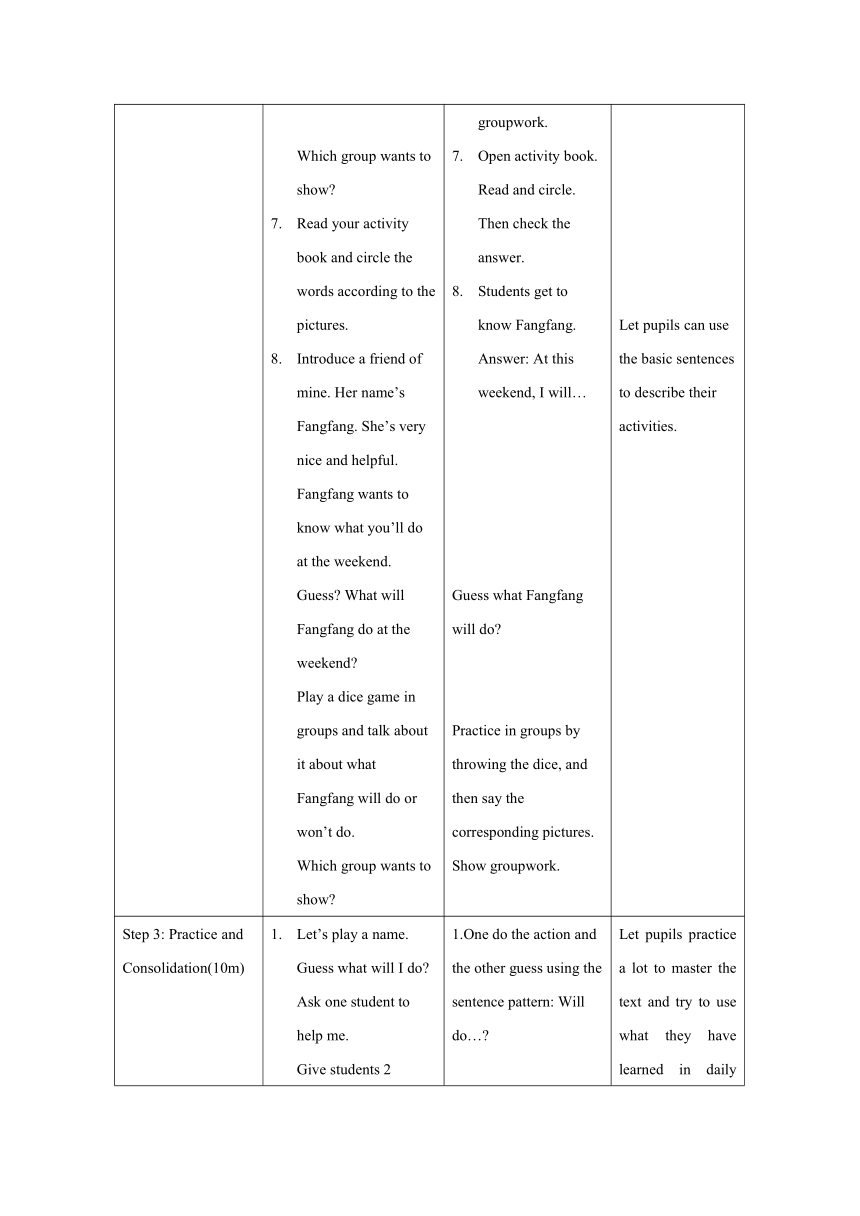外研版(一年级起点)三年级下册 Review Module表格式教案(2课时)
文档属性
| 名称 | 外研版(一年级起点)三年级下册 Review Module表格式教案(2课时) |  | |
| 格式 | docx | ||
| 文件大小 | 43.7KB | ||
| 资源类型 | 教案 | ||
| 版本资源 | 外研版(一年级起点) | ||
| 科目 | 英语 | ||
| 更新时间 | 2022-03-14 08:02:44 | ||
图片预览




文档简介
《英语》(新标准)(小学一起) 三年级下册Review Module教学设计
教材分析 本模块是复习模块。复习本册第一模块到第十模块的语言知识目标。 根据《义务教育英语课程标准(2011年版)》,本模块的英语课程的总体模板是培养学生的综合语言运用能力,目标的各个级别均以学生语言技能,语言知识,情感态度,学习策略和文化意识五个方面的综合行为表现为基础进行总体描述。 在复习模块第一单元,主要复习本册书中第一、二、三、五模块的语言知识目标。 在复习模块第二单元,主要复习本册书中第四、六、七、八、九、十模块的语言知识目标。
模块教学目标 复习目标: 复习本册书中各个模块的语言知识目标。 复习使用形容词描述人物的性格特点和地方的特征。 复习用will描述将来发生的活动。 复习数词的用法以及名词复数。 复习用was/were谈论过去的事情和状态,以及培养学生使用was/ were对过去的事物或人物状态提问的能力。 能力目标: 通过完成各个活动对本学期学习过的知识进行巩固和综合运用。培养学生的交际能力及学生综合运用语言的能力。 情感目标: 营造英语学习的氛围,积极与他人合作,能体会到英语学习的乐趣。
教学重点及难点 1.运用形容词描述人物的性格特点以及地方的特征。 2.用will陈述未来活动以及will的一般疑问句的运用。 3.数词与名词单复数的用法。 4. There is/are…结构的使用。 5.用was/were谈论过去的事情和状态,以及培养学生使用was/were对过去的事物或人物状态提问的能力。
教学辅助 PPT, picture cards, dice, stickers.
教学策略 Task-based teaching method, communicative learning method, Pair work, Group work
教学过程
第一课时教学设计
教材分析 本课时是复习模块第一单元,主要复习本册书中第一、二、三、五模块的语言知识目标。 本模块的词汇主要有:nice, quiet, naughty, clever, shy, tall, new, old, high, wide, long, etc. 本模块的句型主要有:It’s very …. This weekend, XX will. He / She won’t…. Will you… Yes, I will./ No, I won’t. 本模块的功能:了解描述特征、询问将来等交际功能的基本表达形式。
课时教学目标 1. 复习使用形容词描述人物的性格特点和地方的特征:nice, shy, clever, quiet, helpful, naughty, tall, new, old, high, wide, long, etc. 2. 复习用will描述将来发生的活动。 3. 复习will的一般疑问句的运用:Will… Yes, will. / No, …won’t.
教学重点与难点 运用形容词描述人物的性格特点以及地方地特征。 用will陈述未来活动以及will的一般疑问句的运用。
教学辅助 PPT, picture cards, dice, stickers
教学策略 Task-based teaching method, communicative learning method, Pair work, Group work
教学内容(含时间设置) 教学活动 设计意图
教师活动 学生活动
Step 1: warming up(5m) 1. Greetings. 2. T: Let’s chant. 3. (Show the picture about exercise 1 on p62.) Q: What are they like (Give tips) 1. Greeting. 2. T: Chant together. 3. Answer the Q: He / She is… . Let pupils be interested in studying and get ready for the class. Review the words about some adjectives on personal characters.
Step 2: Presentation(23m) Listen and number. Read and complete. Watch a video about London. Please say the places about London you see as quick as you can. (Show pictures about River Thames, London Eye, Big Ben, Tower Bridge) What do you know about these pictures. Read together. Group work. Work in your group and talk about the pictures using the sentence pattern: It’s very... Which group wants to show Read your activity book and circle the words according to the pictures. Introduce a friend of mine. Her name’s Fangfang. She’s very nice and helpful. Fangfang wants to know what you’ll do at the weekend. Guess What will Fangfang do at the weekend Play a dice game in groups and talk about it about what Fangfang will do or won’t do. Which group wants to show Students listen and number the pictures. Read the pictures and complete the sentences. Watch the video about London. Say the places about London they know. Students say the name of the pictures. Students answer: This is Big Ben. It’s very tall and old… Read together. Students practice in groups using the words such as tall, new, old, high, wide and long. Students show their groupwork. Open activity book. Read and circle. Then check the answer. Students get to know Fangfang. Answer: At this weekend, I will… Guess what Fangfang will do Practice in groups by throwing the dice, and then say the corresponding pictures. Show groupwork. Guide students to practice the words about how to describe personal characters and the objects or places features. Arouse the knowledge in their memory according to the video. Guide students to learn by themselves by their groups. Let pupils can use the basic sentences to describe their activities.
Step 3: Practice and Consolidation(10m) Let’s play a name. Guess what will I do Ask one student to help me. Give students 2 minutes to practice. 2. Guide students to talk about what they will do at the weekend in groups. 1.One do the action and the other guess using the sentence pattern: Will do… Practice in groups and talk about what I will do at the weekend. Let pupils practice a lot to master the text and try to use what they have learned in daily life.
Step 4: Summary(2m) Make a summary. What have you learnt today Guide students to collating the knowledge they’ve learnt by themselves.
Classroom Assessment
家庭作业:1. Make a mind map about the use of adjective words and the use of “will”. 2. Talk about your weekend.
第二课时教学设计
教材分析 本课时为复习模块第二单元,主要复习本册书中第四、六、七、八、九、十模块的语言知识目标。 本模块的词汇主要有:twenty, thirty, forty, thirteen, fifteen, eighteen, nineteen, Monday, Tuesday, Wednesday, Thursday, Friday, Saturday, Sunday, etc. 本模块的句型主要有:How many… There are…. XX was /were…then. Now XX was/were … Were you… Yes, I was./ No, I wasn’t. I’ll…. 本模块的功能:谈论数量、询问将来、谈论过去等交际功能的基本表达形式。
课时教学目标 1. 复习数词的用法以及名词复数。 2. 复习用was/were谈论过去的事情和状态,以及培养学生使用was/were对过去的事物或人物状态提问的能力。 3. 复习用will描述将来发生的活动。
教学重点与难点 1.数词与名词单复数的用法。 2. There is/ are…结构的使用。 3.用was/were谈论过去的事情和状态,以及培养学生用was/were对过去的事物或人物状态提问的能力。 4.使用will谈论将要进行的活动。
教学辅助 PPT,picture cards, stickers
教学策略 Task-based teaching method, communicative learning method, Pair work, Group work
教学内容(含时间设置) 教学活动 设计意图
教师活动 学生活动
Step 1: warming up(5M) 1.Greetings 2. Play a game: Magic eyes. Please say the words as quickly as you can. 1. Greeting. 2. Students say the words as quickly as they can. Review the numbers through the game. It can activates the interests and enthusiasm of students.
Step 2: Presentation(20m) Look at the picture. Q: How many pears are there Pairwork: Point, ask and answer. Show 2 words. Q: Who can tell the difference between then and now Look at Ms Li. I was in Classroom A. Now I am in Classroom C. Q: How about the children, the desks and the man Who can help me to put the words in right order. How do we answer the questions Read in groups. Play a game “paper, scissor, store”, ask and answer in pairs. A: Were you at the farm yesterday B: Yes, I was. Show pairwork. 5.Group work: Ask and Answer. Were you… I do, you say. Show a weekly plan. I say first. I’ll wash my trousers on Monday. How about the other days Look at the picture. And answer “there are 20 pears”. Point, ask and answer in pairs how many…. Tell the difference between then and now. Then means the past tense. Now means the present tense. Answer: The children were in Classroom A. Now they’re in Classroom B. The desks were… The man was… 4.Ask and answer in pairs by playing the game. The pupil who wins the game say the picture he likes. Show pairwork. 5. Practice the sentence pattern in pairs. 6. Say Monday to Sunday according to teacher. Talk about the weekly plan. Raise the students’ interests. Present the knowledge we have learnt through the game. It can help the students understand and knowledge. Put the Ss in an English surrounding. Have the Ss get to know how to do this exercise. Guide pupils to do some exercises to consolidate the knowledge about the past tense. Using the TPR to practice the words about week. It’s interesting for students to extract the knowledge.
Step 3: Practice and Consolidation(10m) 1. Let’s play a name. Choose your favorite week. And say the picture behind it. 2. Talk about your plan on weekend in your group. Show your weekend plan. Choose a “week” and practice the sentence. Talk about my plan in my group. Consolidate the knowledge we learned today.
Step 4: Summary(5m)) What have you learnt today Tell the knowledge learnt today. Guide students to conclude the present tense and the past tense of the verb Be and its usage.
Classroom Assessment
家庭作业:1. Make a mind map about the use of past tense. Do a survey. What will your friends do at the weekend
教材分析 本模块是复习模块。复习本册第一模块到第十模块的语言知识目标。 根据《义务教育英语课程标准(2011年版)》,本模块的英语课程的总体模板是培养学生的综合语言运用能力,目标的各个级别均以学生语言技能,语言知识,情感态度,学习策略和文化意识五个方面的综合行为表现为基础进行总体描述。 在复习模块第一单元,主要复习本册书中第一、二、三、五模块的语言知识目标。 在复习模块第二单元,主要复习本册书中第四、六、七、八、九、十模块的语言知识目标。
模块教学目标 复习目标: 复习本册书中各个模块的语言知识目标。 复习使用形容词描述人物的性格特点和地方的特征。 复习用will描述将来发生的活动。 复习数词的用法以及名词复数。 复习用was/were谈论过去的事情和状态,以及培养学生使用was/ were对过去的事物或人物状态提问的能力。 能力目标: 通过完成各个活动对本学期学习过的知识进行巩固和综合运用。培养学生的交际能力及学生综合运用语言的能力。 情感目标: 营造英语学习的氛围,积极与他人合作,能体会到英语学习的乐趣。
教学重点及难点 1.运用形容词描述人物的性格特点以及地方的特征。 2.用will陈述未来活动以及will的一般疑问句的运用。 3.数词与名词单复数的用法。 4. There is/are…结构的使用。 5.用was/were谈论过去的事情和状态,以及培养学生使用was/were对过去的事物或人物状态提问的能力。
教学辅助 PPT, picture cards, dice, stickers.
教学策略 Task-based teaching method, communicative learning method, Pair work, Group work
教学过程
第一课时教学设计
教材分析 本课时是复习模块第一单元,主要复习本册书中第一、二、三、五模块的语言知识目标。 本模块的词汇主要有:nice, quiet, naughty, clever, shy, tall, new, old, high, wide, long, etc. 本模块的句型主要有:It’s very …. This weekend, XX will. He / She won’t…. Will you… Yes, I will./ No, I won’t. 本模块的功能:了解描述特征、询问将来等交际功能的基本表达形式。
课时教学目标 1. 复习使用形容词描述人物的性格特点和地方的特征:nice, shy, clever, quiet, helpful, naughty, tall, new, old, high, wide, long, etc. 2. 复习用will描述将来发生的活动。 3. 复习will的一般疑问句的运用:Will… Yes, will. / No, …won’t.
教学重点与难点 运用形容词描述人物的性格特点以及地方地特征。 用will陈述未来活动以及will的一般疑问句的运用。
教学辅助 PPT, picture cards, dice, stickers
教学策略 Task-based teaching method, communicative learning method, Pair work, Group work
教学内容(含时间设置) 教学活动 设计意图
教师活动 学生活动
Step 1: warming up(5m) 1. Greetings. 2. T: Let’s chant. 3. (Show the picture about exercise 1 on p62.) Q: What are they like (Give tips) 1. Greeting. 2. T: Chant together. 3. Answer the Q: He / She is… . Let pupils be interested in studying and get ready for the class. Review the words about some adjectives on personal characters.
Step 2: Presentation(23m) Listen and number. Read and complete. Watch a video about London. Please say the places about London you see as quick as you can. (Show pictures about River Thames, London Eye, Big Ben, Tower Bridge) What do you know about these pictures. Read together. Group work. Work in your group and talk about the pictures using the sentence pattern: It’s very... Which group wants to show Read your activity book and circle the words according to the pictures. Introduce a friend of mine. Her name’s Fangfang. She’s very nice and helpful. Fangfang wants to know what you’ll do at the weekend. Guess What will Fangfang do at the weekend Play a dice game in groups and talk about it about what Fangfang will do or won’t do. Which group wants to show Students listen and number the pictures. Read the pictures and complete the sentences. Watch the video about London. Say the places about London they know. Students say the name of the pictures. Students answer: This is Big Ben. It’s very tall and old… Read together. Students practice in groups using the words such as tall, new, old, high, wide and long. Students show their groupwork. Open activity book. Read and circle. Then check the answer. Students get to know Fangfang. Answer: At this weekend, I will… Guess what Fangfang will do Practice in groups by throwing the dice, and then say the corresponding pictures. Show groupwork. Guide students to practice the words about how to describe personal characters and the objects or places features. Arouse the knowledge in their memory according to the video. Guide students to learn by themselves by their groups. Let pupils can use the basic sentences to describe their activities.
Step 3: Practice and Consolidation(10m) Let’s play a name. Guess what will I do Ask one student to help me. Give students 2 minutes to practice. 2. Guide students to talk about what they will do at the weekend in groups. 1.One do the action and the other guess using the sentence pattern: Will do… Practice in groups and talk about what I will do at the weekend. Let pupils practice a lot to master the text and try to use what they have learned in daily life.
Step 4: Summary(2m) Make a summary. What have you learnt today Guide students to collating the knowledge they’ve learnt by themselves.
Classroom Assessment
家庭作业:1. Make a mind map about the use of adjective words and the use of “will”. 2. Talk about your weekend.
第二课时教学设计
教材分析 本课时为复习模块第二单元,主要复习本册书中第四、六、七、八、九、十模块的语言知识目标。 本模块的词汇主要有:twenty, thirty, forty, thirteen, fifteen, eighteen, nineteen, Monday, Tuesday, Wednesday, Thursday, Friday, Saturday, Sunday, etc. 本模块的句型主要有:How many… There are…. XX was /were…then. Now XX was/were … Were you… Yes, I was./ No, I wasn’t. I’ll…. 本模块的功能:谈论数量、询问将来、谈论过去等交际功能的基本表达形式。
课时教学目标 1. 复习数词的用法以及名词复数。 2. 复习用was/were谈论过去的事情和状态,以及培养学生使用was/were对过去的事物或人物状态提问的能力。 3. 复习用will描述将来发生的活动。
教学重点与难点 1.数词与名词单复数的用法。 2. There is/ are…结构的使用。 3.用was/were谈论过去的事情和状态,以及培养学生用was/were对过去的事物或人物状态提问的能力。 4.使用will谈论将要进行的活动。
教学辅助 PPT,picture cards, stickers
教学策略 Task-based teaching method, communicative learning method, Pair work, Group work
教学内容(含时间设置) 教学活动 设计意图
教师活动 学生活动
Step 1: warming up(5M) 1.Greetings 2. Play a game: Magic eyes. Please say the words as quickly as you can. 1. Greeting. 2. Students say the words as quickly as they can. Review the numbers through the game. It can activates the interests and enthusiasm of students.
Step 2: Presentation(20m) Look at the picture. Q: How many pears are there Pairwork: Point, ask and answer. Show 2 words. Q: Who can tell the difference between then and now Look at Ms Li. I was in Classroom A. Now I am in Classroom C. Q: How about the children, the desks and the man Who can help me to put the words in right order. How do we answer the questions Read in groups. Play a game “paper, scissor, store”, ask and answer in pairs. A: Were you at the farm yesterday B: Yes, I was. Show pairwork. 5.Group work: Ask and Answer. Were you… I do, you say. Show a weekly plan. I say first. I’ll wash my trousers on Monday. How about the other days Look at the picture. And answer “there are 20 pears”. Point, ask and answer in pairs how many…. Tell the difference between then and now. Then means the past tense. Now means the present tense. Answer: The children were in Classroom A. Now they’re in Classroom B. The desks were… The man was… 4.Ask and answer in pairs by playing the game. The pupil who wins the game say the picture he likes. Show pairwork. 5. Practice the sentence pattern in pairs. 6. Say Monday to Sunday according to teacher. Talk about the weekly plan. Raise the students’ interests. Present the knowledge we have learnt through the game. It can help the students understand and knowledge. Put the Ss in an English surrounding. Have the Ss get to know how to do this exercise. Guide pupils to do some exercises to consolidate the knowledge about the past tense. Using the TPR to practice the words about week. It’s interesting for students to extract the knowledge.
Step 3: Practice and Consolidation(10m) 1. Let’s play a name. Choose your favorite week. And say the picture behind it. 2. Talk about your plan on weekend in your group. Show your weekend plan. Choose a “week” and practice the sentence. Talk about my plan in my group. Consolidate the knowledge we learned today.
Step 4: Summary(5m)) What have you learnt today Tell the knowledge learnt today. Guide students to conclude the present tense and the past tense of the verb Be and its usage.
Classroom Assessment
家庭作业:1. Make a mind map about the use of past tense. Do a survey. What will your friends do at the weekend
同课章节目录
- Module 1
- Unit 1 She’s very nice.
- Unit 2 I’m going to help her.
- Module 2
- Unit 1 It’s very long.
- Unit 2 You’ll see Tower Bridge.
- Module 3
- Unit 1 We'll go to the zoo.
- Unit 2 Will we have breakfast at 7?
- Module 4
- Unit 1 We'll pick fruit.
- Unit 2 Thirteen,fourteen,fifteen...
- Module 5
- Unit 1 Will you take your ball tomorrow?
- Unit 2 On Monday,I'll go swimming.
- Module 6
- Unit 1 Here are his hands.
- Unit 2 There is a small monster.
- Module 7
- Unit 1 Are there many children in your class?
- Unit 2 How many apples are there in the box?
- Module 8
- Unit 1 He works hard.
- Unit 2 She's quite good at English.
- Module 9
- Unit 1 They were very young.
- Unit 2 He was in Hong Kong.
- Module 10
- Unit 1 Were you on the second floor?
- Unit 2 It was there.
- Review Module
- Unit 1
- Unit 2
